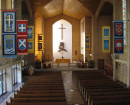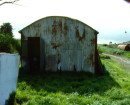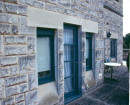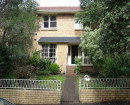Back to search results
TOORAK/SOUTH YARRA LIBRARY
338-344 TOORAK ROAD SOUTH YARRA, STONNINGTON CITY
TOORAK/SOUTH YARRA LIBRARY
338-344 TOORAK ROAD SOUTH YARRA, STONNINGTON CITY
All information on this page is maintained by Heritage Victoria.
Click below for their website and contact details.
Victorian Heritage Register
-
Add to tour
You must log in to do that.
-
Share
-
Shortlist place
You must log in to do that.
- Download report

Toorak South Yarra Library 2025












On this page:
Statement of Significance
The Toorak/South Yarra Library is located on Wurundjeri Country.
What is significant?
The Toorak/South Yarra Library is a municipal library building of minimal modernist design completed in 1973. It was designed by Barry Patten of Yuncken Freeman architects and is distinguished by its expression as a steel and glass-walled box that appears to float above a recessed plinth. The interior of the main public area is a voluminous open space. The building sits within landscaped grounds to the east and west that include mature Golden Wych Elms (Ulmus glabra lutescens). A mixed-media sculptural work by Lauren Berkowitz titled Collected Histories was installed in 1995 and is an object integral to the place.
How is it significant?
The Toorak/South Yarra Library is of architectural significance to the State of Victoria. It satisfies the following criterion for inclusion in the Victorian Heritage Register:
Criterion D
Importance in demonstrating the principal characteristics of a class of cultural places and objects.
Criterion D
Importance in demonstrating the principal characteristics of a class of cultural places and objects.
Why is it significant?
Toorak/South Yarra Library is architecturally significant as a notable example of both a municipal library and a modernist building in the formal minimalist style. It is one of Victoria’s finest examples of the formal minimalist architecture developed by influential German-born architect Ludwig Mies van der Rohe. The Library’s restrained and elegant design, featuring regularly spaced black steel columns and vast areas of glazing, imparts a clarity of form and physical transparency. It represents one of the most distinctive and architecturally fine libraries and municipal public buildings erected in the era and is an important, smaller-scale work of Yuncken Freeman Architects. The landscaped setting for the building includes plantings of Golden Wych Elms that have been planted in locations to highlight the repetitive steel columns of the building. The artwork in the foyer, by accomplished artist Lauren Berkowitz, has long been a prominent feature within the building.
(Criterion D)
Show more
Show less
-
-
TOORAK/SOUTH YARRA LIBRARY - History
Municipal libraries in Victoria
The earliest libraries in Victoria were associated with Mechanics Institutes, the first being the Melbourne Mechanics Institute established in 1839. Mechanics Institutes, ‘free libraries’ and similar organisations proliferated throughout the colony and provided access to journals and books to paying subscribed members. The Melbourne Public Library (now, the State Library of Victoria) was established in 1856 and was the first free public library in Australia and one of the first in the world. During the nineteenth and early twentieth centuries a small number of municipal councils established library services for public use.
In the 1930s, the Carnegie Corporation, established by American philanthropist Andrew Carnegie, funded a survey of Australian libraries. The survey highlighted the many limitations of library services in Victoria. In response, a Library Service Board was established in 1940. Immediately following the end of World War II, there was a demand for community facilities of all types, as well as government support for community rebuilding. The establishment of dedicated local public libraries by municipal authorities began in a meaningful way in this period.
In Victoria, the Free Library Service Board Act was introduced in 1946 to oversee a new system of government funding for local libraries. This, combined with the demand for increased municipal services in the post-war period, led to a boom in the establishment of municipal public library services. In the immediate post-war period, most libraries were established in pre-existing buildings. Several purpose-built library buildings began to appear in regional centres in Victoria in the early 1950s, where funding for capital works was more easily accessed.
From the late 1950s, purpose-built municipal library buildings began to appear throughout metropolitan Melbourne. By 1966, public libraries were operated by 115 local authorities in Victoria. Purpose-built municipal libraries initially tended to be architecturally unremarkable but focused on internal planning and providing for the varied needs of library users.
Toorak/South Yarra Library
The City of Prahran’s Toorak branch library had several temporary homes before plans emerged for a purpose-built library around 1970. The Mayor of Prahran, Cr CCE Gahan, promised a facility that would be ‘a modern library… which will not only lend books but also provide space for reading and lectures and study areas for students.’ Land for the library was donated by prominent Melbourne developers Jack and Eddie Kornhouser in memory of their late brother, Bernard. In 1971, Yuncken Freeman Architects Pty Ltd was commissioned to design the library, with senior partner Barry Patten (1927–2003), who lived locally, taking the lead. The firm of Yuncken Freeman had its origins in the 1930s, and by the 1950s emerged as one of Victoria’s most important commercial practices, designing a series of significant office towers in Melbourne (see comparisons). The firm, and Patten in particular, were exponents of the architectural approach of influential German-born, US-based architect Ludwig Mies van der Rohe and Patten’s design for the Toorak/South Yarra Library was an explicit homage to Mies’ SR Crown Hall (1956) at the Illinois Institute of Technology in Chicago.
The foundation stone for the Toorak/South Yarra Library was laid in August 1972 and the building was officially opened in August 1973. Although criticising features such as its overly formal interior design, Architect magazine described the building as ‘a precise, cool building which keeps itself to itself’ and as an ‘urban sculpture… an erudite essay’.
The Library has been a popular municipal building with the City of Prahran (subsequently the City of Stonnington) since its opening. This has necessitated several changes over its lifespan, including recarpeting the floors and redesigning the service desk on at least two occasions. Window frames and glazing were replaced in 2000, maintaining the striking appearance of the building. In 2024, the original Yuncken Freeman entrance ramps were replaced with ADA-compliant ramps and stairs. The library continues to welcome an average of 400 people a day. The building’s importance was recognised by its inclusion in the National Trust’s register as a building of State-level significance in 2000. It has also been recognised by DOCOMOMO and the Australian Institute of Architects (Victorian Chapter).
Selected bibliographyBuilt Heritage, Survey of Post-War Built Heritage in Victoria Stage Two: Assessment of Community and Administrative Facilities, 2010.
GJM Heritage, South Yarra Heritage Review, Toorak-South Yarra Library, 338-344 Toorak Road, South Yarra, Heritage Citation, March 2025.
Heritage Alliance, Survey of Post-War Built Heritage in Victoria: Stage One, 2008.
Goad, Philip, ‘Yuncken Freeman’, The Encyclopedia of Australian Architecture, Philip Goad and Julie Willis (eds), Port Melbourne: Cambridge University Press, 2012.
Lewi, Hannah & Nichols, David (eds), Community: Building Modern Australia, Sydney: UNSW Press, 2010.
National Trust of Australia (Victoria) Classification Report, Toorak/South Yarra Branch Library (FN 7079).
‘Toorak/South Yarra Branch Library’, Architect, Sept-October 1973, Vol. 3 Number 28.
TOORAK/SOUTH YARRA LIBRARY - Permit Exemptions
General Exemptions:General exemptions apply to all places and objects included in the Victorian Heritage Register (VHR). General exemptions have been designed to allow everyday activities, maintenance and changes to your property, which don’t harm its cultural heritage significance, to proceed without the need to obtain approvals under the Heritage Act 2017.Places of worship: In some circumstances, you can alter a place of worship to accommodate religious practices without a permit, but you must notify the Executive Director of Heritage Victoria before you start the works or activities at least 20 business days before the works or activities are to commence.Subdivision/consolidation: Permit exemptions exist for some subdivisions and consolidations. If the subdivision or consolidation is in accordance with a planning permit granted under Part 4 of the Planning and Environment Act 1987 and the application for the planning permit was referred to the Executive Director of Heritage Victoria as a determining referral authority, a permit is not required.Specific exemptions may also apply to your registered place or object. If applicable, these are listed below. Specific exemptions are tailored to the conservation and management needs of an individual registered place or object and set out works and activities that are exempt from the requirements of a permit. Specific exemptions prevail if they conflict with general exemptions. Find out more about heritage permit exemptions here.Specific Exemptions:The works and activities listed below under the heading ‘Exempt works and activities’ are not considered to cause harm to the cultural heritage significance of Toorak/South Yarra Library. These are subject to the following guidelines and conditions:
Guidelines for specific permit exemptions
1. Where there is an inconsistency between permit exemptions specific to the registered place or object (‘specific exemptions’) established in accordance with either section 49(3) or section 92(3) of the Act and general exemptions established in accordance with section 92(1) of the Act specific exemptions will prevail to the extent of any inconsistency.
2. In specific exemptions, words have the same meaning as in the Act, unless otherwise indicated. Where there is an inconsistency between specific exemptions and the Act, the Act will prevail to the extent of any inconsistency.
3. Nothing in specific exemptions obviates the responsibility of a proponent to obtain the consent of the owner of the registered place or object, or if the registered place or object is situated on Crown Land the land manager as defined in the Crown Land (Reserves) Act 1978, prior to undertaking works or activities in accordance with specific exemptions.
4. If a Cultural Heritage Management Plan in accordance with the Aboriginal Heritage Act 2006 is required for works covered by specific exemptions, specific exemptions will apply only if the Cultural Heritage Management Plan has been approved prior to works or activities commencing. Where there is an inconsistency between specific exemptions and a Cultural Heritage Management Plan for the relevant works and activities, Heritage Victoria must be contacted for advice on the appropriate approval pathway.
5. Specific exemptions do not constitute approvals, authorisations or exemptions under any other legislation, Local Government, State Government or Commonwealth Government requirements, including but not limited to the Planning and Environment Act 1987, the Aboriginal Heritage Act 2006, and the Environment Protection and Biodiversity Conservation Act 1999 (Cth). Nothing in this declaration exempts owners or their agents from the responsibility to obtain relevant planning, building or environmental approvals from the responsible authority where applicable.
6. Care should be taken when working with heritage buildings and objects, as historic fabric may contain dangerous and poisonous materials (for example lead paint and asbestos). Appropriate personal protective equipment should be worn at all times. If you are unsure, seek advice from a qualified heritage architect, heritage consultant or local Council heritage advisor.
7. The presence of unsafe materials (for example asbestos, lead paint etc) at a registered place or object does not automatically exempt remedial works or activities in accordance with this category. Approvals under Part 5 of the Act must be obtained to undertake works or activities that are not expressly exempted by the below specific exemptions.
8. All works should be informed by a Conservation Management Plan prepared for the place or object. The ED is not bound by any Conservation Management Plan and permits still must be obtained for works suggested in any Conservation Management Plan.
General conditions for specific permit exemptions
1. All works or activities permitted under specific exemptions must be planned and carried out in a manner which prevents harm to the registered place or object.?Harm includes moving, removing or damaging any part of the registered place or object that contributes to its cultural heritage significance.
2. If during the carrying out of works or activities in accordance with specific exemptions original or previously hidden or inaccessible details of the registered place are revealed relating to its cultural heritage significance, including but not limited to historical archaeological remains, such as features, deposits or artefacts, then works must cease and Heritage Victoria notified as soon as possible.
3. If during the carrying out of works or activities in accordance with specific exemptions any Aboriginal cultural heritage is discovered or exposed at any time, all works must cease and the Secretary (as defined in the Aboriginal Heritage Act 2006) must be contacted immediately to ascertain requirements under the Aboriginal Heritage Act 2006.
4. If during the carrying out of works or activities in accordance with specific exemptions any munitions or other potentially explosive artefacts are discovered, Victoria Police is to be immediately alerted and the site is to be immediately cleared of all personnel.
5. If during the carrying out of works or activities in accordance with specific exemptions any suspected human remains are found the works or activities must cease. The remains must be left in place and protected from harm or damage. Victoria Police and the State Coroner’s Office must be notified immediately. If there are reasonable grounds to believe that the remains are Aboriginal, the State Emergency Control Centre must be immediately notified on 1300 888 544, and, as required under s.17(3)(b) of the Aboriginal Heritage Act 2006, all details about the location and nature of the human remains must be provided to the Aboriginal Heritage Council (as defined in the Aboriginal Heritage Act 2006).
Exempt works and activities
Landscape
1. Gardening and soft landscape maintenance (for example: weeding, mulching, planting, pruning and tree lopping).
2. Repairs and maintenance to hard landscape elements (for example: walls, paths and steps) with like-for-like materials and finishes.
3. Repairs and maintenance to the two original fixed signs on the library grounds, and replacement of the non-original plexiglass signage within the original steel structures.
4. Removal of trees when they pose a risk to people or property (this exemption does not apply to the Gold Wych Elms to the east and west of the building).
5. Removal of Gold Wych Elms when they pose a risk to people or property, provided they are replaced with an example of the same or similar species in the same location.
6. Repairs, maintenance and removal of the outdoor timber seating area, located on the western open space area.
7. Repairs, maintenance and removal of street and park furniture (for example: bins, benches, bollards and bicycle hoops).
8. Installation of standard council street and park furniture provided it is installed in the open areas to the east, west or south of the library building.
9. Sub-surface and drainage works to the south side of the building.
Library building exterior10. All repairs and maintenance to the roof, and the replacement of roof cladding and flashings with like-for-like materials and finishes.
11. All repairs, maintenance and replacement of the solar energy system, and installation of additional solar panels provided that the appearance of the building from street level is not altered.
12. All repairs and maintenance to the external steel structure, including repainting, with like-for-like materials, finishes and colours.
13. All repairs and maintenance to the windows (for example: resealing, cracks etc) provided the existing visual appearance is maintained.
14. All repairs and maintenance to the concrete retaining wall that surrounds the rear carpark to the south of the site.
15. All like for like repairs and maintenance to the staircase and ramps located within the front setback (including balustrades).
16. All repairs and maintenance to the exterior rendered concrete wall that forms the base of the building (for example: repairing any cracking) provided works are planned and carried out in consultation with an appropriately experienced Heritage Advisor.
17. Works to the bin cage at rear of building, including removal.
18. Installation and removal of temporary banners and signage (related to celebrations, events, and community activities, excluding advertising) affixed to exterior surface of windows, provided that the temporary banners or signage are in place for no more than three months per year.
Library building interior
19. All non-structural works within the lower ground floor (exclusive of staircase).
20. All works to the existing customer service desk and associated fixtures, provided they do not impact any elements of the original building.
21. All works within the toilets, kitchens, IT/Server/Print Room, plant room and staff administration areas.
22. All works to the existing specialist library infrastructure and equipment (for example: PC stations and self-checkout machines) required for the day-to-day functioning of the place as a library.
23. All works to the passenger lift (for example: repairs, maintenance and replacement of the lift system).
24. All works to services, plant, HVAC and emergency management systems within existing locations.
25. All repairs and maintenance to the book returns lift.
26. Like-for-like repairs and maintenance of the balustrade and glazing surrounding the staircase, as well as the staircase itself, in the entry foyer.
27. Like-for-like repairs and maintenance of the internal glazing that faces the entry foyer.
28. Replacement of floor coverings (for example: carpet and linoleum).
29. Replacement of non-original light fittings.
30. Installation of artwork and signage to the surface of the services core that faces the foyer.
31. Installation and removal of temporary banners and signage (related to celebrations, events, and community activities, excluding advertising) affixed to interior surface of windows, provided that the temporary banners or signage are in place for no more than three months per year.
Semi-detached plant room and substation at rear of library building
33. All works to the substation/plant building within the existing building envelope.
Flood management
34. All repairs, maintenance and rectification works required as a result of a flood event.Objects integral
35. All repairs, maintenance and conservation of the Collected Histories artwork, located in the entry foyer, provided works are undertaken by the artist or an appropriately qualified art conservator.
36. Relocation of the Collected Histories artwork, provided it remains within the entry foyer.
TOORAK/SOUTH YARRA LIBRARY - Permit Exemption Policy
It is recommended that a Conservation Management Plan be utilised to manage the place in a manner that respects its cultural heritage significance.
-
-
-
-
-
PRIMARY SCHOOL NO. 1467
 Victorian Heritage Register H1032
Victorian Heritage Register H1032 -
FORMER RECHABITE HALL
 Victorian Heritage Register H0575
Victorian Heritage Register H0575 -
MELBOURNE HIGH SCHOOL
 Victorian Heritage Register H1636
Victorian Heritage Register H1636
-
1 Barkly Avenue
 Yarra City
Yarra City -
1 Clifton Street
 Yarra City
Yarra City -
1 Laura Place
 Yarra City
Yarra City
-
-












